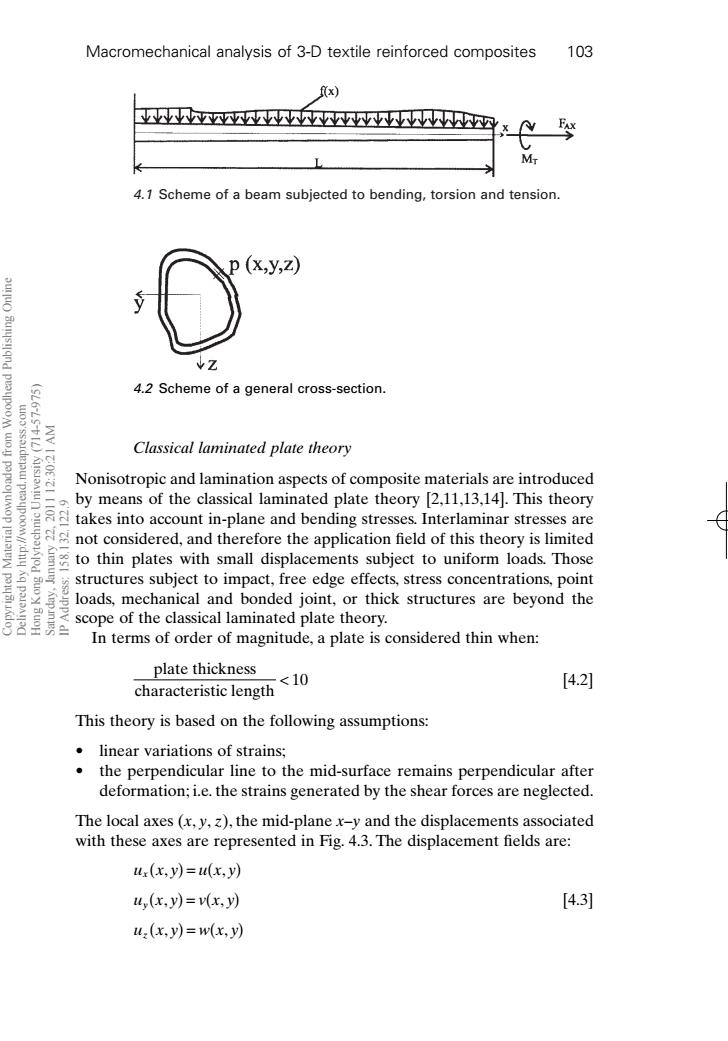正在加载图片...

Macromechanical analysis of 3-D textile reinforced composites 103 M 4.1 Scheme of a beam subjected to bending,torsion and tension. (x,y,Z) Z 4.2 Scheme of a general cross-section. WV IZOE Classical laminated plate theory Nonisotropic and lamination aspects of composite materials are introduced 9 by means of the classical laminated plate theory [2,11,13,14].This theory takes into account in-plane and bending stresses.Interlaminar stresses are not considered,and therefore the application field of this theory is limited to thin plates with small displacements subject to uniform loads.Those structures subject to impact,free edge effects,stress concentrations,point loads,mechanical and bonded joint,or thick structures are beyond the scope of the classical laminated plate theory. In terms of order of magnitude,a plate is considered thin when: plate thickness characteristic length <10 [4.2] This theory is based on the following assumptions: linear variations of strains; the perpendicular line to the mid-surface remains perpendicular after deformation;i.e.the strains generated by the shear forces are neglected. The local axes(x,y,z),the mid-plane x-y and the displacements associated with these axes are represented in Fig.4.3.The displacement fields are: ux(x,y)=u(x,y) u,(x,y)=v(x,y) [4.3] u.(x,y)=w(x,y)Macromechanical analysis of 3-D textile reinforced composites 103 Classical laminated plate theory Nonisotropic and lamination aspects of composite materials are introduced by means of the classical laminated plate theory [2,11,13,14]. This theory takes into account in-plane and bending stresses. Interlaminar stresses are not considered, and therefore the application field of this theory is limited to thin plates with small displacements subject to uniform loads. Those structures subject to impact, free edge effects, stress concentrations, point loads, mechanical and bonded joint, or thick structures are beyond the scope of the classical laminated plate theory. In terms of order of magnitude, a plate is considered thin when: [4.2] This theory is based on the following assumptions: • linear variations of strains; • the perpendicular line to the mid-surface remains perpendicular after deformation; i.e. the strains generated by the shear forces are neglected. The local axes (x, y, z), the mid-plane x–y and the displacements associated with these axes are represented in Fig. 4.3. The displacement fields are: [4.3] u xy wxy z ( ) , , = ( ) u xy vxy y ( ) , , = ( ) u xy uxy x ( ) , , = ( ) plate thickness characteristic length < 10 4.1 Scheme of a beam subjected to bending, torsion and tension. 4.2 Scheme of a general cross-section. RIC4 7/10/99 7:43 PM Page 103 Copyrighted Material downloaded from Woodhead Publishing Online Delivered by http://woodhead.metapress.com Hong Kong Polytechnic University (714-57-975) Saturday, January 22, 2011 12:30:21 AM IP Address: 158.132.122.9